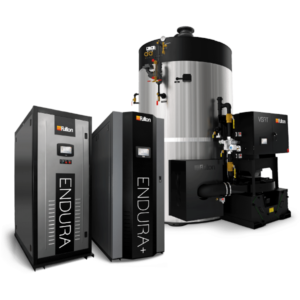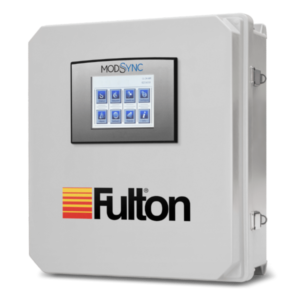Fulton Controls
PURE™ Control
Controls
For More Information:

Integrated Boiler Control System
The PURE™ Control was developed specifically to optimize Fulton boilers. Sequence up to 10 boilers with no master or standalone panel requirements.
- Powerful and Intuitive Sequencing Control
- Maximizes Boiler Performance
- Simplifies Commissioning
- Color Touchscreen Display
- Simple and Intuitive Navigation
Powerful & Intuitive
Efficiently sequence (lead/lag) up to 10 boilers with parallel staging and eliminate the need for a master boiler or standalone panel. If a boiler is powered off for service, the plant seamlessly transitions to the next available stage, maximizing uptime and redundancy.
Simplified Operation
The PURE Control maximizes performance and facilitates operation with easy-to-use features including a graphical Proportional Integral Derivative (PID) controller and highly configurable burner modulation parameters. Commissioning and fine tuning your boiler has never been easier.
Detailed History
Track operation with extensive trending data capabilities, boiler usage and estimated efficiency. The advanced analytics capability can be accessed directly on-screen, or may be exported to a USB flash drive for enhanced viewing on a desktop computer.
Hydronic Device Integration Features
- Pump Control (Primary or Duty/Standby Secondary)
- 0-10 VDC Output for Pump VFD Modulation
- Motorized Isolation Valve Control
- Domestic Hot Water Priority and Temperature Monitoring
- Outdoor Air Temperature Monitoring and Setpoint Reset
- Supply and Return Header Temperature Monitoring
ModSync®
Controls
For More Information:

Boiler Plant Sequencing Control
Fulton’s ModSync is a highly optimized sequencing control that matches boiler output to system load, minimizing boiler cycling and extending equipment life. ModSync provides centralized monitoring of your entire boiler plant with Lead/Lag up to 8 steam or hydronic boilers.
- User-Friendly Touchscreen Interface
- Outdoor Air Temperature Reset
- Pump or Valve Control with Interlocks
- General alarm contact
- Remote Enable / Disable
Intuitive
The easy-to-use touchscreen interface brings your entire boiler plant together into a centralized easy to use control hub.
Streamlined
Improve your building operations with rapid access to boiler status, history and hand-off-auto capabilities.
Flexible
The ModSync SE features assignable analog and digital inputs and outputs for vast configuration possibilities to integrate boilers, pumps, valves and other devices.
Upgrade your ModSync Experience (Modsync®LX)
- Large 12.1” Color Touchscreen Display
- Accommodates systems with 9 or more boilers
- Ideal for projects with hybrid plants, legacy equipment, and more
- Custom I/O, Sequences, and Algorithms available
- Factory tailored to satisfy the unique needs of special applications

Flame by Wire
Controls
For More Information:

Electronic Air-Fuel Ratio Combustion Control & O2 Compensation System
Inspired by advances in automotive and aviation, Flame-by-Wire™ technology replaces the use of conventional pneumatic (“neg-reg”) and mechanical linkage systems with a modern system of independently controlled electronic air and gas valves. It is easier to service and tune by empowering technicians to accurately dial-in positions electronically. Integrated O2 Compensation autonomously tunes the air-fuel ratio to adjust for changes in seasonality, maximizing combustion efficiency.
- Dramatically improves the ease of boiler commissioning and maintenance
- Maximizes boiler up-time reliability
- Saves fuel, reducing emissions and lowering energy bills
Benefits over Neg-Reg and Linkage:
- Estimated fuel savings of up to 8% compared to conventional air/fuel ratio controls.
- Precise combustion ratio control that doesn’t drift off-course.
- Superior flame stability; exceptionally tolerant of varying conditions with fewer site callbacks.
- Provides technicians significantly more flexibility in configuring the combustion curve.
- Less sensitive to pressure effects from wind, room pressure and flue draft.
- 10 combustion points (including discrete ignition) compared to conventional 2-point linear controls.
